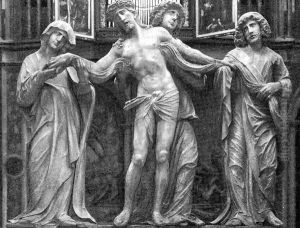Adolf Daucher Paintings
Adolf Daucher was a German sculptor and carver who is best known for his work in the Late Gothic and early Renaissance periods. His exact date of birth is not known, but he is thought to have been born around 1460, possibly in the city of Ulm, which was a significant center for the arts during this time. Daucher is particularly noted for his work in the medium of alabaster, a fine-grained form of gypsum that allows for intricate carving and was popular for devotional sculptures and altarpieces.
Daucher's career spanned a period of transition in European art, bridging the gap between Gothic traditions and the emerging humanistic styles that characterized the Renaissance. His work demonstrates a keen attention to detail and a mastery of form, typical of the Gothic style, while also incorporating a growing interest in naturalism and the study of the human figure, which were hallmarks of Renaissance art.
One of his most significant works is the High Altar of Ulm Minster, on which he worked from 1510 to 1521. This masterpiece showcases his skill in creating three-dimensional figures that are both expressive and detailed, bringing biblical scenes to life. Daucher's other notable works include the Magdalenenkapelle in Nördlingen and the Scholasterkapelle in Ulm, both of which feature his characteristic alabaster sculptures.
Adolf Daucher's influence extended beyond his lifetime, as he was part of a family of artists and his workshop continued under his son-in-law, Hans Daucher, who was also a prominent sculptor. The exact date of Adolf Daucher's death is as uncertain as that of his birth, but it is generally believed that he died around 1523. His legacy is seen in the continuation of his style in the works of subsequent generations of German artists.
